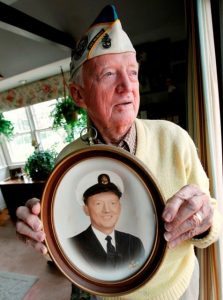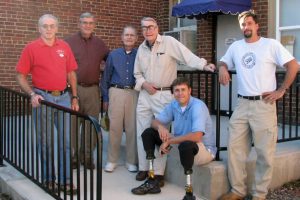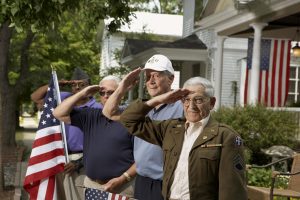What Aging in Place Means for Veterans
May 19, 2014
We’re thrilled to have Sarah Stevenson, writer for A Place for Mom’s Senior Living Blog, sharing her unique insight with us today. A Place for Mom assists seniors and their families in their search for quality senior care and housing in their area.
In this article, Sarah discusses the growing trend of aging in place, and programs that can help senior veterans to accomplish this.
Home is not only where the heart is; it’s also a source of pride and independence.
When my grandfather – a Pearl Harbor veteran who served in the U.S. Navy – was able to sell his small home and purchase a brand-new house in the late 1980s, he was beyond thrilled. It was where he planned to live out his remaining years, where he planted a garden that was his pride and joy…and it was also where he died, at home in hospice care. It’s the home where my parents now live today.
The term “aging in place” wasn’t really around yet, but that’s what my grandfather did. With the U.S. Census Bureau reporting 43.1 million people over 65 in the United States in 2012, 9.6 million of whom are veterans, the idea of aging in place is becoming a household phrase.
Like my grandfather, many elderly strongly prefer to remain in the community rather than entering a nursing home or senior housing. Fortunately, there are government and non-profit programs designed to help aging veterans stay healthy and—if they so wish—remain in their own homes.
Purple Heart Homes’ Veterans Aging in Place Program
Veterans who are coping with an injury or disability (3.6 million of them, according to the Census) may need extra day-to-day help, whether that’s caregiving assistance or aging in place home modifications.
Bay Alarm Medical is proud to be working with Purple Heart Homes, whose Veterans Aging in Place Program is designed to help homeowning veterans modify their house to fit their changing physical needs. Veterans’ homes are evaluated to determine what modifications are necessary, and for veterans who qualify for the program, those changes are made at no cost to them.
“The objective is to restore both dignity and ‘quality of life’ by creating an injury specific barrier free living environment utilizing the space and structure they have and pairing with Purple Heart Homes resources,” says Purple Heart Homes. Whether it’s wheelchair ramps or accessible bathrooms, the program offers veterans the gift of being able to age in their own homes.
Veteran’s Directed Home and Community-Based Service Program
The U.S. Administration on Aging’s Community Living Program Grants are already helping states serve millions of older adults who prefer to age in place rather than enter a nursing home. Along those same lines, the AoA is partnering with the Veterans Health Administration to institute the Veteran’s Directed Home and Community-Based Service Program, which offers a variety of services to help disabled or chronically ill veterans remain in their homes.
According to the U.S. Department of Veterans’ Affairs, “Veterans in this program are given a flexible budget for services that can be managed by the Veteran or the family caregiver.” That budget can be used to hire personal care aides to assist with activities of daily living or purchase equipment to help veterans live independently.
Because this program is relatively new, it is only available in certain locations, but the good news is, it is automatically included as part of the VHA Standard Medical Benefits Package. This means all VA-enrolled veterans are eligible as long as they meet the clinical need for the service, and providing it is available in their area.
VA Aid & Attendance and Housebound Pension Benefits
Another financial program administered by the VA is the Aid & Attendance and Housebound program. Veterans eligible for a VA pension, who need aid or attendance by another individual to conduct activities of daily living, OR who are largely confined to their homes due to permanent disability or chronic illness, may qualify for this supplement to their pensions. Information on how to apply through your regional VA office is available on the VA’s website.
Interestingly, this is a benefit not many veterans seem to know about, says a 2012 article in the New York Times. The program is underused, and, what’s more, the application process can be confusing. To qualify for a pension in the first place, says the VA, a veteran must be “totally disabled.” But what does that really mean?
“What people don’t know is that when wartime veterans turn 65, the V.A. automatically classifies them as ‘totally disabled,” said Debbie Burak, founder of the nonprofit VeteranAid.org. “And if they meet income and asset criteria, they are eligible for a basic pension.” Her website at VeteranAid.org helps senior veterans and their families through the application process.
With organizations like these on the lookout, senior veterans (and their families) can breathe a sigh of relief: help is out there, and getting older doesn’t have to mean moving out of your own home and into nursing care.
Sources:
http://www.census.gov/newsroom/releases/archives/facts_for_features_special_editions/cb13-ff27.html
http://www.census.gov/newsroom/releases/archives/aging_population/cb14-84.html
http://www.purplehearthomesusa.org/verterans_aging.htm
http://www.aoa.gov/AOARoot/AoA_Programs/HCLTC/NHD/index.aspx#partner
http://www.va.gov/GERIATRICS/Guide/LongTermCare/Veteran-Directed_Care.asp
http://benefits.va.gov/pension/aid_attendance_housebound.asp




